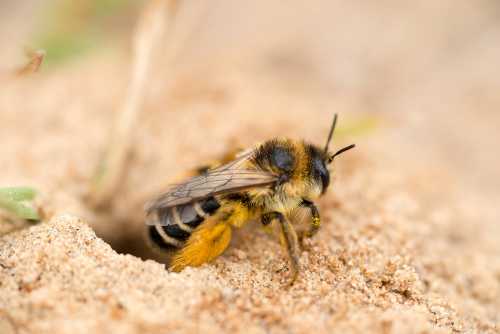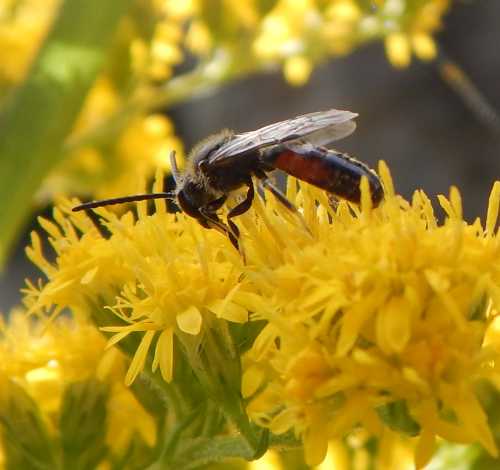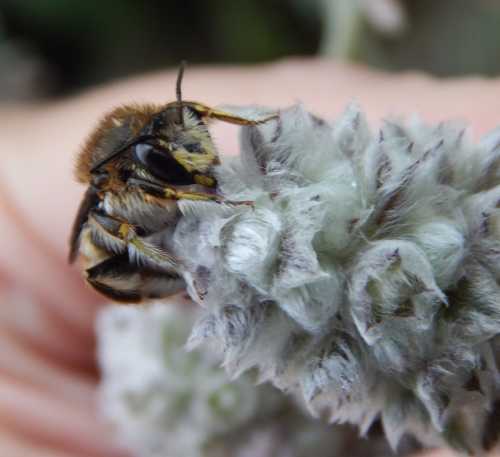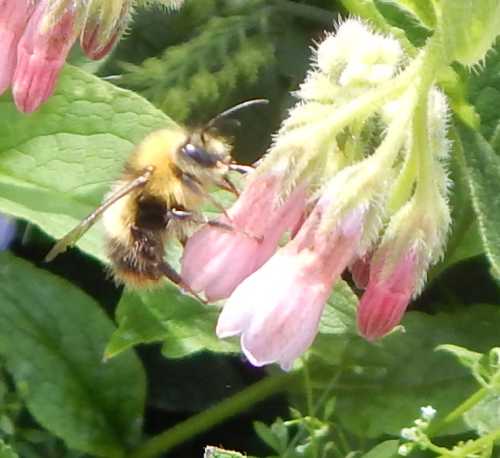Dasypoda hirtipes - The Pantaloon Bee
Below is an image of a female Pantaloon bee, Dasypoda hirtipes, at
the entrance of her nest burrow. Fortunately, this female is revealing those
magnificent pollen brushes on the hind legs.
Hence, the name 'pantaloon' is a fitting one!
About Dasypoda hirtipes - The Pantaloon Bee
The females of this bee species use the beautiful long hairs on their legs not only to carry pollen, but also to help them brush away loose sand as they dig out their nest burrows with their mandibles (jaws).
 Dasypoda hirtipes - The Pantaloon Bee
Dasypoda hirtipes - The Pantaloon Bee
This specie measures about 9 - 11mm in length, and the females have bold pale bands on the thorax. Males lack the 'pantaloons' on the hind legs.
Dasypoda hirtipes belongs to the family Melittidae, which fall in to the category of short-tongued bees. Being a member of the relatively small Melittidae family, pantaloon bees are not commonly seen, and Dasypoda hirtipes is the only bee of the Dasypoda genus found in the UK.
To see it, you'll need to check sandy coastal habitats, dunes, sandy cliffs, heathland, saltmarsh or acid grassland from around June to August.
The Welsh coast and North Norfolk (one of my favourite regions for holidays) are good places to look because they offer large areas of ideal habitat for this lovely bee.
Flowers visited
You’ll find these bees in the habitats described as above, and they may be seen foraging on a wide range of wildflower favourites of many bee species.
Knapweeds, and a variety of thistles may be visited, along with yellow composites, including sowthistle, hawkbit, Cat’s ear, hawk’s beard, Common flea bane and ragworts.
It's usual for these bees to forage in the morning and spend the afternoons at their burrows.
Nesting habits
Once nest construction has begun by the female bee, she then starts to collect pollen which is compacted into a little ball.
Pollen balls are placed in brood cells and an egg is laid on top.
Unlike some species such as plasterer bees, the pantaloon bee, Dasypoda hirtipes does not line her nest cells. Instead she makes a tripod-like structure on which the pollen balls rest, thus avoiding contact with the cell walls (Verreecken et al 20061; El Abdouni et al 20212).
The larvae feed on the pollen ball and do not spin a cocoon. The nests of Dasypoda species are generally deep and can exceed more than 90 cm in depth (Celary 20023).
Worldwide distribution of Dasypoda hirtipes
Dasypoda hirtipes has been recorded as ranging from Morocco, the United Kingdom and Finland to China and the Russian Far East, including a giant aggregation of about 7.56 million nests covering an area of 36 ha along the banks of the Barysh River in Ulyanovsk Region (Russia) (Radchenko 20164 citing Michez et al. 2004b; Proshchalykin 2004; Blagoveshchenskaya 1963).
However, it is proposed that Dasypoda hirtipes is easily confusable with a new species described by Radchenko4 in 2016: Dasypoda Latreille.
References
- Vereecken N, Toffin E, Michez D (2006) Observations relatives à la biologie et la nidification de quelques abeilles sauvages psammophiles d’intérêt en Wallonie. Parcs & Reserves 61: 12–20.)
- El Abdouni I, Lhomme P, Hamroud L, Wood T, Christmann S, Rasmont P, Michez D (2021) Comparative ecology of two specialist bees: Dasypoda visnaga Rossi, 1790 and Dasypoda maura Pérez, 1895 (Hymenoptera, Melittidae). Journal of Hymenoptera Research 81: 109-126. https://doi.org/10.3897/jhr.81.60528
- Celary W (2002) The ground-nesting solitary bee, Dasypoda thoracica BAER, 1853 (Hymenoptera: Apoidea: Melittidae) and its life history. Folia Biologica 50: 191–198.
- Radchenko, Vladimir. (2016). A new widespread European bee species of the genus Dasypoda Latreille (Hymenoptera, Apoidea). Zootaxa. 4184. 491–504. 10.11646/zootaxa.4184.3.4.
If you found this page helpful or interesting, I'd really be grateful if you would share it with others - if not this page, perhaps another, such as Gardening For Bees.
Thank you so much :) .



